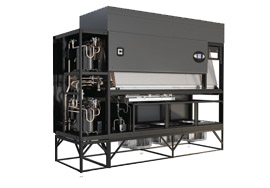A cooling tower is a crucial component in many industrial and commercial facilities. It helps regulate the temperature of a building or system by removing heat from the water used in cooling processes. Regular maintenance is essential for ensuring that cooling towers operate effectively and efficiently. In this article, we provide tips and best practices for cooling tower maintenance.
Types of Cooling Towers
Cooling towers come in a variety of shapes and sizes, each designed for specific applications. The most common types of cooling towers are:
- Natural draft cooling towers: These towers rely on natural air currents to dissipate heat, making them ideal for large-scale operations.
- Forced draft cooling towers: These towers use fans to circulate air and dissipate heat, making them ideal for smaller or more complex cooling systems.
- Induced draft cooling towers: These towers use fans to draw air through the tower, providing enhanced cooling and air flow.
Design and Construction
Cooling towers are engineered to provide maximum cooling efficiency while minimizing the amount of water used. The design of a cooling tower typically includes the following components:
- Fill: The fill is a series of closely spaced material, typically plastic or fiber, that provides a large surface area for heat exchange.
- Basin: The basin is a large, open container that collects water and provides a place for it to be stored.
- Distribution system: The distribution system is responsible for distributing water evenly over the fill material, ensuring maximum cooling efficiency.
- Fan: The fan helps to dissipate heat and regulate air flow through the tower.
Operation
Cooling towers operate by removing heat from the water used in a closed-loop system. The water is pumped into the tower and evenly distributed over the fill material. As the water trickles down through the fill, heat is transferred from the water to the air. The warm air rises and is exhausted out of the top of the tower, while the cooled water is collected in the basin and returned to the closed-loop system.
Key Benefits of Cooling Towers
There are several key benefits to using cooling towers in industrial and power generation applications, including:
- Energy efficiency: Cooling towers allow you to control the temperature of your closed-loop system, reducing the amount of energy required to maintain optimal conditions.
- Water conservation: Cooling towers use significantly less water than other cooling methods, making them a more environmentally friendly choice.
- Cost savings: By reducing energy costs and water usage, cooling towers can help lower overall operating expenses.

Best Practices for Cooling Tower Performance
To maximize the performance of your cooling tower, consider the following best practices:
- Regular maintenance: Regular maintenance, including cleaning and inspecting the fill and basin, can help extend the life of your cooling tower and maintain its efficiency.
- Proper water treatment: Proper water treatment, including pH control and filtration, is essential for maximizing cooling tower performance.
- Monitoring and control: Regular monitoring and control of your cooling tower can help you identify and address potential issues before they become major problems.
Importance of Regular Maintenance
Regular maintenance is essential for ensuring the proper functioning of a cooling tower. Neglecting maintenance can lead to a variety of problems, including decreased efficiency, reduced heat transfer, and increased energy costs. Additionally, failing to properly maintain a cooling tower can lead to the growth of harmful microorganisms, such as Legionella, which can pose a serious health risk.
Essential Maintenance Tips
- Monitor water levels: The water level in the basin should be regularly monitored to ensure that it remains at the proper level. Low water levels can damage the fan and motor, while high water levels can lead to overflowing and waste.
- Clean the fill material: The fill material should be cleaned regularly to remove any debris and ensure optimal heat exchange.
- Check the fan: The fan should be inspected regularly for proper operation, including proper balance and alignment.
- Maintain the motor: The motor should be regularly maintained to ensure that it is operating efficiently and effectively. This may include oiling the bearings and checking the electrical connections.
- Monitor water chemistry: The water chemistry in the cooling tower should be regularly monitored to ensure that it remains within the proper range. This includes monitoring pH levels, total alkalinity, and total hardness.
- Inspect the basin: The basin should be inspected regularly for any signs of cracks or leaks. Any issues should be promptly addressed to prevent water damage and other problems.
- Conduct regular disinfection: Regular disinfection of the cooling tower is essential for preventing the growth of harmful microorganisms, such as Legionella. This may include the use of chlorine or other disinfectants.
In conclusion, regular cooling tower maintenance is essential for ensuring optimal performance and avoiding potential health and safety risks. By following these tips, facility managers can ensure that their cooling tower systems are functioning effectively and efficiently.
Cooling Tower Preventative Maintenance in Northern Virginia
We hope this article has helped you learn more about boiler preventative maintenance and how it can help your business. If you have any questions or would like to speak with a specialist, call us at 703-649-2977 or request service here.
